Looking for an alternative to Basecamp: a review of Unfuddle.com
 After three years of using Basecamp for project management, we found what suits us best. I suggest that users of the site get acquainted with the project management service http://unfuddle.com , its advantages, disadvantages and its comparison with Basecamp.
After three years of using Basecamp for project management, we found what suits us best. I suggest that users of the site get acquainted with the project management service http://unfuddle.com , its advantages, disadvantages and its comparison with Basecamp. Unfuddle.com we found by accident. One of the customers mentioned this service in passing. I went in, looked and I liked it. I liked it so much that now we are gradually moving all our 15+ current projects there.
In the comments, questions like "Is this an advertisement" already appear? No, this is not an advertisement. I have nothing to do with the site (except as a user). There are no referral links in the text.
At the beginning of the article I will describe the main advantages / disadvantages. Next will be a more detailed description.
Key Benefits Compared to Basecamp
- Advanced (compared to Basecamp) ticket support . Everything, of course, is not as cool as in JIRA or in Mantis. Nevertheless, the perfect balance is maintained between simplicity and functionality.
- The sweetest thing is keeping a ticket history . Who added when. Who changed the status, etc.
- Multiple ticket statuses (New, Accepted, Resolved, Closed)
- custom custom fields for tickets.
- More flexible setting of access rights of people to the project. The ability to give read-only access to some part of the project, such as messages.
Other advantages
- Unlimited number of repositories per project. GIT and SVN are standardly supported .
- The ability to resolve tickets and report hours using comments when committing to the repository. For example, adding the line “resolved # 47 spending 2:45 on # 47” to the comment, ticket # 47 will be resolved and 2:45 will be added to the time spent on it.
- Another principle of email reminders. Receiving all messages, tickets, etc. to which you have access with the ability to refuse to receive any type of message (for example, tickets). You can also opt out of receiving alerts about changes that you yourself have made. Ability to select the interval for sending updates: immediately, once every 30 minutes, once per hour, etc.
- Mylyn Connector. We have not used it yet, but there is an opportunity.
- Possibility of automatic bakap on your personal S3 account on Amazon. Also not yet used but the opportunity pleases.
- Project Access API
Fly in the ointment (Drawbacks)
- Design in my opinion is worse than that of Basecamp.
- Little documentation. The community is not as big as Basecamp. Although the support service responds quite quickly and adequately answers questions.
Further in more detail about the site itself (many screenshots).
Prices
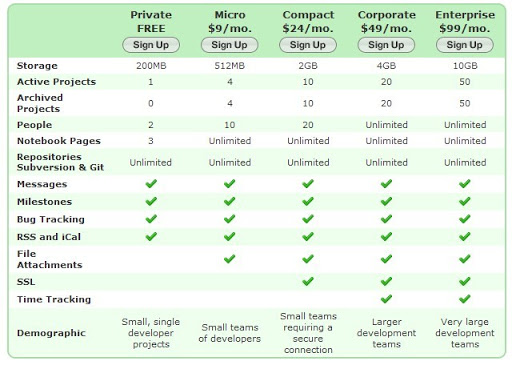
Prices are pretty much the same as Basecamp. A sane account costs the same magic $ 49 / month. At the same time, less disk space is offered (4 Gb instead of 15 Gb for Basescamp) and projects (20 instead of 35).
Dashboard

Fairly standard dashboard. Provides an overview of recent activity on projects.
From the pleasant, you can note a quick view of the status of tickets on the project ..

Project overview
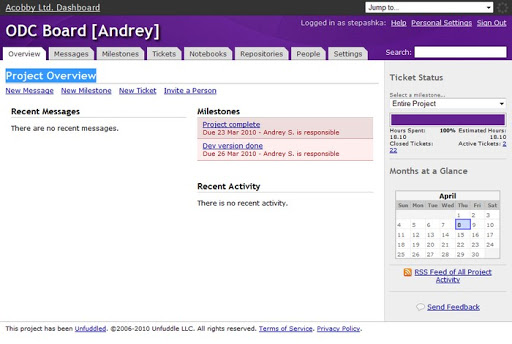
Same standard page as Dashboard.
Messages
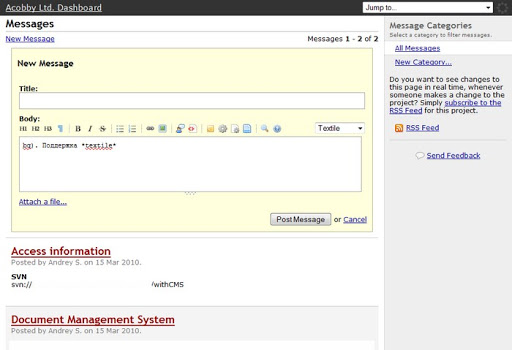
The message section allows you to add messages. Messages can be divided into categories (categories are created in the project settings). Links to tickets, commits in repositories, pages in Notebook can be added to messages. But, the most delicious is that, unlike Basecamp, Textile and Markup are humanly supported (selected in the settings).
Milestones
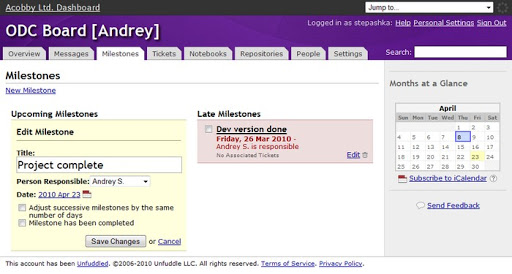
When adding a milestone, the person responsible for it is selected. Milestones are displayed on the calendar.
Tickets

Convenient list of tickets. You can do group actions (change attributes, resolve). There are 6 predefined ticket reports (list on the right side of the page). It’s very convenient that you can create your own reports.

With such a flexible reporting system, you can get a list for any purpose. When creating a report, you can specify:
- grouping according to one of the parameters (component, version, milestone, date, etc.)
- field by which to sort and direction of sorting
- ticket fields to be included in the list
- ticket selection criteria for the list

(link the full page of the ticket)
When viewing a ticket, the status of the ticket (New, Accepted, Resolved, Closed), as well as the time spent flowing in comparison with the rating, are clearly displayed. Very convenient since allows you to evaluate the “health” of the ticket without reading it.
Notebook
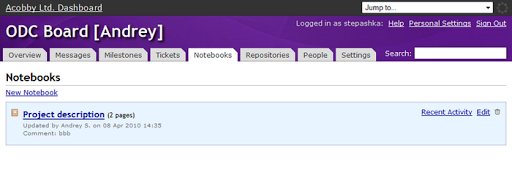
The structure of the notebook is different from Basecamp. In Unfuddle, a notebook is created which consists of data pages. I don’t quite understand the logic of the creators of the service. Here, after all, it's not a library, but a project. How many large documents can be created here? 10? fifteen? All these documents could well fit in a simple list.
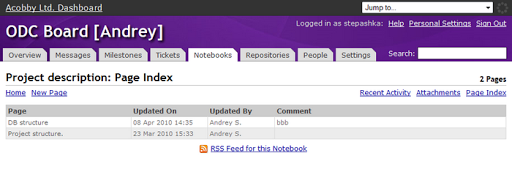
You can add pages to each notebook.
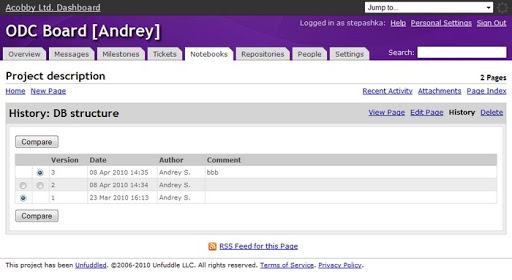
It is possible to view page versions, compare with previous versions.
Repositories

List of repositories showing activity for a certain time. When you hover over the columns with the mouse, it shows the number of commits per tribute. If you click on the name of the repository, you can view the source of the project.
People

As I wrote above, one of the advantages of the system. On the left is a list of users who have access to the project. You can edit access to each of the sections of the project. Access rights can be: None (section is not visible), Read Only, Read and Create, Manage (can edit what others did).
On the right is a list of people in the system. You can add them to the project. while they are not in the project, they do not see the project.
Above is the link “Invite a Person”. Allows you to create an account for the user. Immediately sends an invitation letter to the user.
Project settings
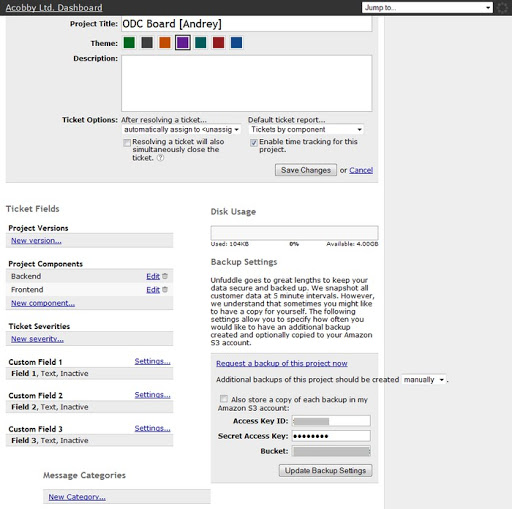
Basic project settings: Name, description. Unlike Basecamp, it allows you to specify a color for each project, and not for the interface as a whole. You can select the default actions for tickets.
Below are settings for versions and project components, message categories, custom fields for tickets. There is also setting access to the S3 account to create a backup copy of the project. Backup can also be downloaded to your computer. And you can choose one of the last 4 backups.
Personal settings
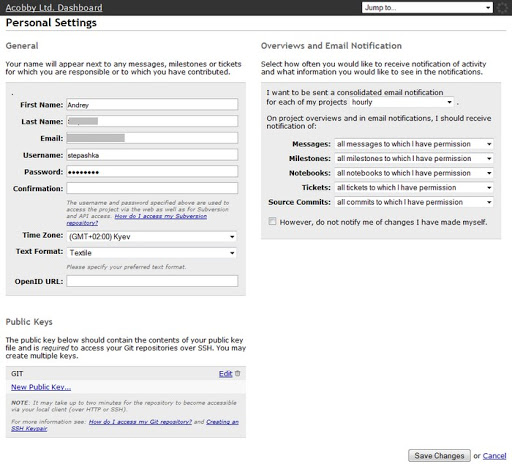
Personal settings, name, password, time zone, etc. There are also email notification settings. They are global, affect all projects. Below are the keys for accessing the Git repository.
Account settings
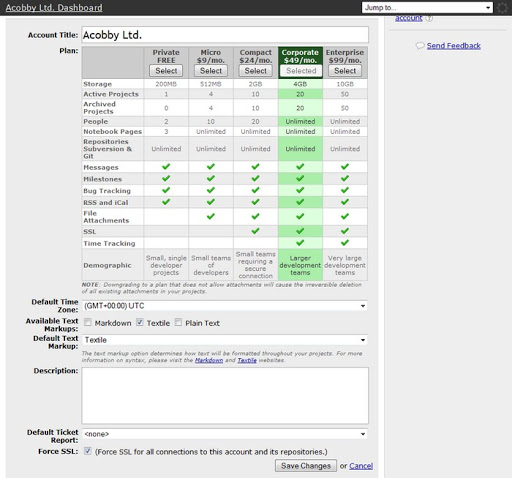
Settings of the used plan, time zone, default markup languages. Useful bird "Force SSL" allows you to automatically switch to https when using the site.
It seems that he wrote everything that he himself investigated.
If you don’t have enough information, you can write to me. How can I help you.
Or see it yourself: http://unfuddle.com/ , Unfuddle Support
